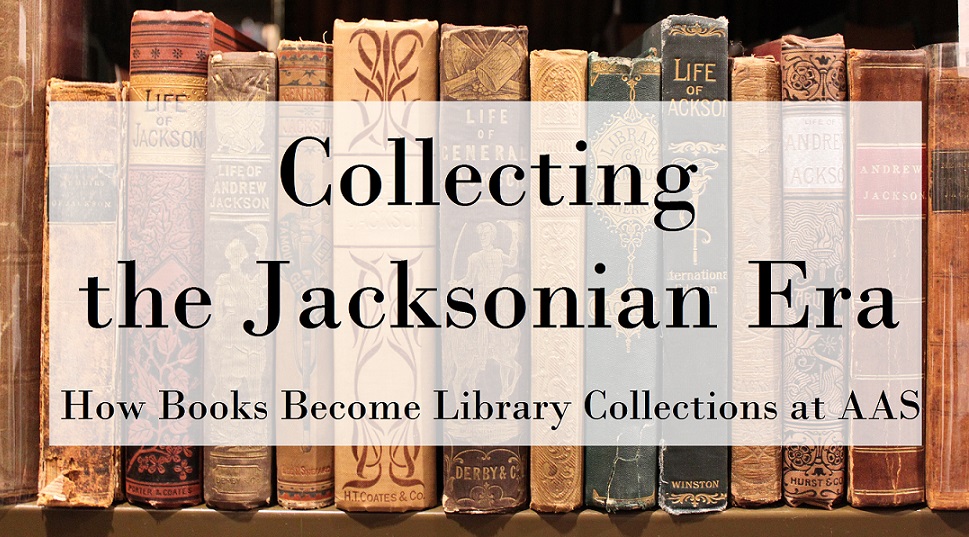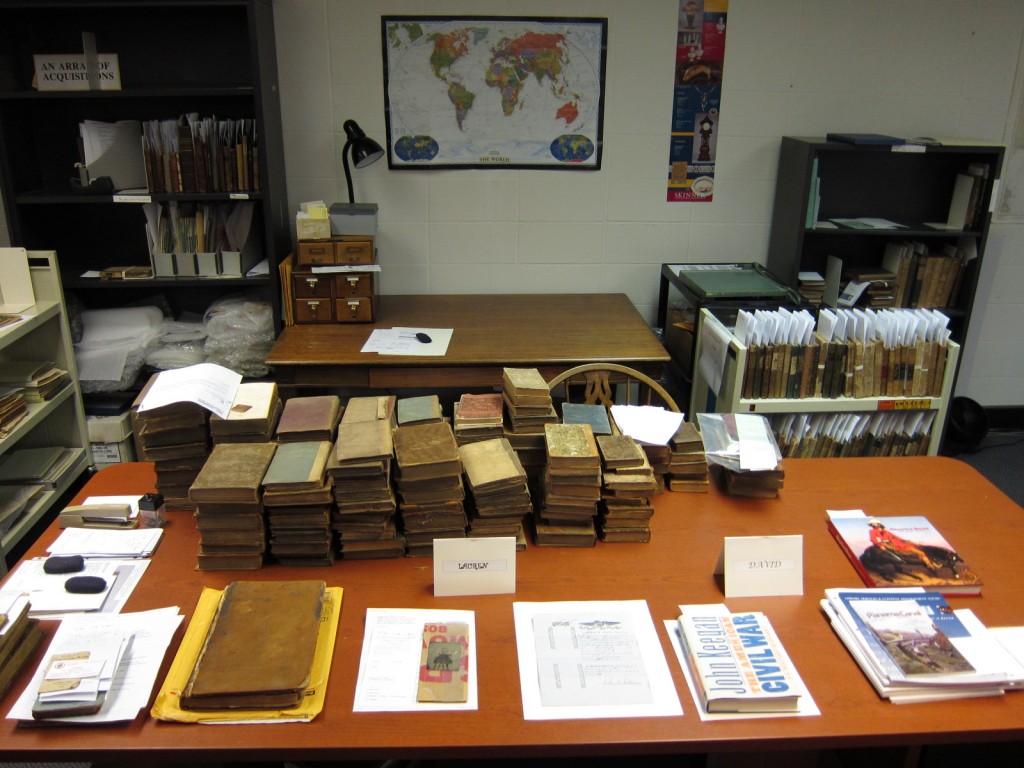Acquire & Accession

Click here to learn more about this broadside advertisement for a New Museum, one of the more recent additions to the William C. Cook Jacksonian Era Collection that has been flagged by acquisitions staff for conservation review.
"The happiest moments of my life are those employed in opening packages of books presented to the Library of the American Antiquarian Society. It gives me real, substantial, and unadulterated comfort."
The Acquisitions Table
AAS librarian Christopher Columbus Baldwin wrote these words in 1834, but the tradition of taking great joy in opening boxes of books continues to the present. Each morning the mail carrier brings a new carton of deliveries to the AAS Acquisitions Department. Then there is the unwrapping of boxes, the digging around in the bubble wrap and packing peanuts, the thrill of the occasional unexpected treasure waiting to be
revealed inside. All new arrivals to AAS must first land on the central acquisitions table before they are distributed to various departments and curators. Like tags on a present, signs with each curator’s name appear atop the items they need to check and approve. Staff members often drop by to see the newest arrivals. In an attempt to spread this cheer beyond the walls of the Acquisitions Department, a regular feature known as The Acquisitions Table was added to the AAS blog, Past is Present, to replicate in virtual form the serendipity of browsing the acquisitions table.
The Acquisitions Department serves as a hub for newly arrived materials. Here critical connections are maintained between curators and catalogers and conservators, donors and book dealers, and everyone from the mail carrier who brings in the boxes to the administrative staff who pay the bills and balance the budget. In recent years, the role of the Acquisitions Department has become even more important as the volume of material received has increased exponentially, especially if the count includes individual newspaper issues. Compared with a decade ago, AAS now acquires ten times as many items with the same amount of staff. The number of items acquired increased from about two thousand items in 2005 to about twenty thousand in 2015. Keeping track of it all requires an especially skilled and dedicated staff.
The Acquisitions Slip (or, The Book’s Passport)
A book has reached a surprisingly dangerous point in its journey when it lands on the acquisitions table, because there are so many directions in which it might go from here. Sometimes a book was sent “on approval” from a dealer and it may need to be returned. It may need to be reviewed by the Conservation Department to determine if a mold situation is treatable or be photographed for a report on recent acquisitions. From the acquisitions table, the newspapers, graphic arts, and manuscripts all go on different journeys to their various curatorial departments while the books go up to the main cataloging department staff.
To maintain control over the hundreds of items arriving weekly, each potential acquisition receives an acquisitions slip that travels with it until it reaches its final destination. This slip serves as a passport, marking its journey through the various way stations of the AAS library. It is stamped with the date of the item’s arrival and is marked up as it travels along the way for curatorial approvals, acknowledgment (for donations) or payment (for purchases), conservation review, housing, cataloging, etc. until it reaches its forever home in the AAS stacks.
The Path Out of Acquisitions
Upon their arrival, the books in the William C. Cook Jacksonian Era Collection followed a slightly different path—one reserved for those collections that arrive as part of a crowd. Since a single table could not hold them all, the books ended up on book trucks and then in special “swing space” shelving reserved for large collections.
As with all collections, once the books receive curatorial approval they are given brief catalog records with a call number of “In Process” plus the date they are being accessioned. This breadcrumb allows for better tracking of any books that may go off the rails. The catalog records for items that arrive together are linked to a purchase order (even for donations) in the acquisitions module that is connected to AAS’s online catalog. For donations, an acknowledgment letter is mailed; for purchases an invoice is generated so a check can be cut for the vendor.
Each book is then physically accessioned in pencil, marking it as part of AAS collections for security purposes. In the case of the William C. Cook Jacksonian Era Collection, the books received a custom printed bookplate. Some books receive additional secret markings and special codes—but some things have to remain a secret! The final part of the accessioning of an item involves its physical protection. Items arriving in a particularly fragile state are flagged by acquisitions staff so they can be reviewed by AAS conservators before they go out into the hands of researchers.

